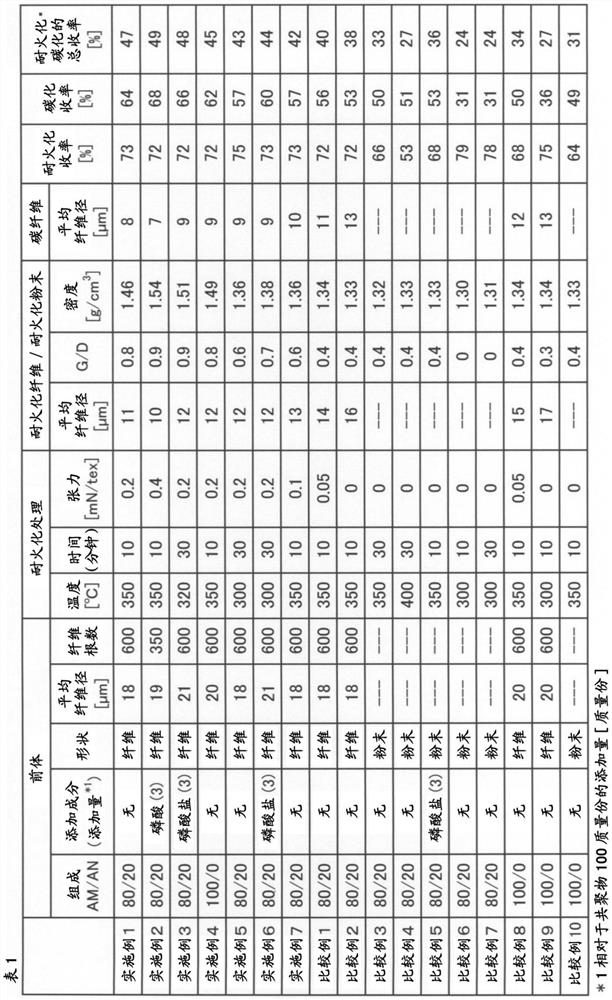Fire-resistant fiber, method for producing same, and method for producing carbon fiber
A manufacturing method and technology of carbon fiber, which is applied in the field of refractory chemical fiber, can solve the problems of low density and G/D value of refractory chemical fiber bundles, reduced carbonization yield, low productivity, etc., and achieve the effect of high yield
- Summary
- Abstract
- Description
- Claims
- Application Information
AI Technical Summary
Problems solved by technology
Method used
Image
Examples
manufacture example 1
[0072] The AM / AN copolymer (AM / AN=80mol% / 20mol%) powder (p-1) obtained in Preparation Example 1 was dissolved in ion-exchanged water, and the obtained aqueous solution was used for dry spinning to produce an acrylamide-based polymer Fiber (f-1).
[0073]
[0074] 100 obtained acrylamide-based polymer fibers (f-1) were bundled to produce an acrylamide-based polymer fiber bundle, the mass of the fiber bundle was measured, and the fineness of the fiber bundle was calculated by the following formula:
[0075] Fiber bundle fineness [tex] = fiber bundle mass [g] / fiber length [m]×1000[m]
[0076] The fineness of the single fibers constituting the fiber bundle (the fineness of the acrylamide-based polymer fiber (f-1)) was determined to be 0.33 tex / fiber.
[0077]
[0078] The density of the acrylamide-based polymer fiber bundle was measured using a dry-type automatic density meter ("Akupick II1340" manufactured by Micromeritics Co., Ltd.), and the average fiber diameter of the si...
manufacture example 2
[0084]Dissolve the AM / AN copolymer (AM / AN=80mol% / 20mol%) powder (p-1) obtained in Preparation Example 1 in ion-exchanged water, and add 100 parts by mass of the AM / AN copolymer to the obtained aqueous solution 3 parts by mass of phosphoric acid to completely dissolve it. Dry spinning was performed using the obtained aqueous solution to produce acrylamide-based polymer fibers (f-2). The fineness, average fiber diameter, and density of the acrylamide-based polymer fiber (f-2) were obtained in the same manner as in Production Example 1, and the fineness was 0.38 tex / fiber, the average fiber diameter was 19 μm, and the density was 1.26 g / cm 3 .
manufacture example 3
[0086] An acrylamide-based polymer fiber (f-3) was produced in the same manner as in Production Example 2, except that 3 parts by mass of diammonium hydrogenphosphate was added instead of phosphoric acid with respect to 100 parts by mass of the AM / AN copolymer. The fineness, average fiber diameter, and density of the acrylamide-based polymer fiber (f-3) were obtained in the same manner as in Production Example 1, and the fineness was 0.46 tex / fiber, the average fiber diameter was 21 μm, and the density was 1.26 g / cm 3 .
PUM
| Property | Measurement | Unit |
|---|---|---|
| density | aaaaa | aaaaa |
| density | aaaaa | aaaaa |
| density | aaaaa | aaaaa |
Abstract
Description
Claims
Application Information
 Login to View More
Login to View More - R&D
- Intellectual Property
- Life Sciences
- Materials
- Tech Scout
- Unparalleled Data Quality
- Higher Quality Content
- 60% Fewer Hallucinations
Browse by: Latest US Patents, China's latest patents, Technical Efficacy Thesaurus, Application Domain, Technology Topic, Popular Technical Reports.
© 2025 PatSnap. All rights reserved.Legal|Privacy policy|Modern Slavery Act Transparency Statement|Sitemap|About US| Contact US: help@patsnap.com

